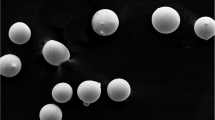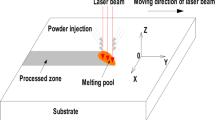Abstract
To avoid the effects of the overlap phenomenon among powder particles, the concept of an effective particle number was introduced, and multi-parameter analytical models for laser powder-fed additive manufacturing (LPF-AM) cladding geometric characteristics were established based on the laws of energy and mass conservation. Experimental research on the LPF-AM of a FeCr alloy was carried out, and the theoretical results are discussed and compared with the experimental data from the perspective of the laser energy density and powder density. The results showed that the cladding area was proportional to both the laser energy density and powder density. The mixing area and dilution rate decreased gradually with increasing powder density, while they increased first and then decreased with increasing laser energy density. The analytical model calculation values fit well with the experimental measurements. The microstructure of the cladding layer and substrate showed good metallurgical bonding, and the micro-hardness variation from the mixing to the cladding zone ranged from 423 to 627 HV.







Similar content being viewed by others
References
Gorunov AI (2018) Complex refurbishment of titanium turbine blades by applying heat-resistant coatings by direct metal deposition. Eng Fail Anal 86:115–130
Jiang QY (2019) Improvement of microstructure, hardness, and mechanical properties of cobalt-based amorphous coating via laser cladding. Strength Mater 51(3):450–461
Li YX, Su KQ, Bai PK, Liu B, Su HW, Du WB (2019) Effect of TiBCN content on microstructure and properties of laser cladding Ti/TiBCN composite coatings. Met Mater Int 25:166–1377
Liu YF, Weng F, Bi GJ, Chew YX, Liu SB, Ma GY, Moon SK (2019) Characterization of wear properties of the functionally graded material deposited on cast iron by laser-aided additive manufacturing. Int J Adv Manuf Technol 105:4097–4105
Wang WJ, Fu ZK, Cao X, Guo J, Liu QY, Zhu MH (2016) The role of lanthanum oxide on wear and contact fatigue damage resistance of laser cladding Fe-based alloy coating under oil lubrication condition. Tribol Int 94:470–478
Zhang P, Zhang DZ, Peng DH, Li ZH, Mao ZH (2018) Rolling contact fatigue performance evaluation of Ti–6Al–4V parts processed by selective laser melting. Int J Adv Manuf Technol 96:3533–3543
Hu DM, Kovacevic R (2003) Sensing, modeling and control for laser-based additive manufacturing. Int J Mach Tools Manuf 43:51–60
Wang JH, Han FZ, Chen SF, Ying WS (2019) A novel model of laser energy attenuation by powder particles for laser solid forming. Int J Mach Tools Manuf 145:103440
Lalas C, Tsirbas K, Salonitis K, Chryssolouris G (2006) An analytical model of the laser clad geometry. Int J Adv Manuf Technol 32:34–41
Fathi A, Toyserkani E, Khajepour A, Durali M (2006) Prediction of melt pool depth and dilution in laser powder deposition. J Phys D Appl Phys 39:2613–2623
Campanelli SL, Angelastro A, Signorile CG, Casalino G (2016) Investigation on direct laser powder deposition of 18 Ni (300) marage steel using mathematical model and experimental characterization. Int J Adv Manuf Technol 89:885–895
Wang XL, Deng DW, Hu YB, Liu ZC, Zhang HC (2017) Analytical modeling and experimental investigation of laser clad geometry. Opt Eng 56(9):096104
Barekat M, Shoja R, Ghasemi A (2016) Nd:YAG laser cladding of Co-Cr-Mo alloy on γ-TiAl substrate. Opt Laser Technol 80:145–152
Ansari M, Shoja R, Barekat M (2016) An empirical-statistical model for coaxial laser cladding of NiCrAlY powder on Inconel 738 superalloy. Opt Laser Technol 86:136–144
Nabhani M, Shoja R, Barekat M (2018) An empirical-statistical model for laser cladding of Ti-6Al-4V powder on Ti-6Al-4V substrate. Opt Laser Technol 100:265–271
Mohammad E, Hassan AP, Hamidreza MS, Shoja R (2016) An empirical-statistical model for laser cladding of WC-12Co powder on AISI 321 stainless steel. Opt Laser Technol 97:180–186
Ocelík V, Nenadl O, Palavra A, Hosson D (2014) On the geometry of coating layers formed by overlap. Surf Coat Technol 242:54–61
Nenadl O, Kuipers W, Koelewijn N, Ocelík V (2016) A versatile model for the prediction of complex geometry in 3D direct laser deposition. Surf Coat Technol 307:292–300
Huang YZ, Khamesee B, Toyserkani E (2016) A comprehensive analytical model for laser powder-fed additive manufacturing. Addit Manuf 12:90–99
Shi JJ, Zhu P, Fu GY, Shi SH (2018) Geometry characteristics modeling and process optimization in coaxial laser inside wire cladding. Opt Laser Technol 101:341–348
Reddy L, Preston SP, Shipway PH, Davis C, Hussain T (2018) Process parameter optimisation of laser clad iron based alloy: predictive models of deposition efficiency, porosity and dilution. Surf Coat Technol 349:198–207
Liu HM, Qin XP, Huang S, Hu ZQ, Ni M (2018) Geometry modeling of single track cladding deposited by high power diode laser with rectangular beam spot. Opt Lasers Eng 100:38–46
Xi WC, Song BX, Zhao Y, Yu TB, Wang J (2019) Geometry and dilution rate analysis and prediction of laser cladding. Int J Adv Manuf Technol 103:4695–4702
Zhu SC, Chen WL, Ding LP, Zhan XH, Chen Q (2019) A mathematical model of laser cladding repair. Int J Adv Manuf Technol 103:3265–3278
Jouvard JM, Grevey DF, Lemoine F, Vannes AB (1997) Continuous wave Nd:YAG laser cladding modeling: a physical study of track creation during low power processing. J Laser Appl 9:43–50
Partes K, Seefeld T, Sepold G, Vollertsen F (2005) Increased efficiency in laser cladding by optimization of beam intensity and travel speed. Proc SPIE 61570O:1–11
Tabernero I, Lamikiz A, Martínez S, Ukar E, Lacalle LN (2012) Modelling of energy attenuation due to powder flow-laser beam interaction during laser cladding process. J Mater Process Technol 212:516–522
Wang Q, Li JY, Gouge M, Michaleris P, Reutzal EW (2017) Physics-based multivariable modeling and feedback linearization control of melt-pool geometry and temperature in directed energy deposition. J Manuf Sci Eng 139:021013
Kaplan AFH (2014) Laser absorptivity on wavy molten metal surfaces: categorization of different metals and wavelengths. J Laser Appl 26(1):012007
Zhang ZD, Huang YZ, Kasinathan AR, Shahabad SL (2019) 3-dimensional heat transfer modeling for laser powder-bed fusion additive manufacturing with volumetric heat sources based on varied thermal conductivity and absorptivity. Opt Laser Technol 109:297–312
Matthews M, Trapp J, Guss G, Rubenchik A (2018) Direct measurements of laser absorptivity during metal melt pool formation associated with powder bed fusion additive manufacturing processes. J Laser Appl 30(3):032302
Pinkerton AJ, Li L (2004) An analytical model of energy distribution in laser direct metal deposition. Proc Inst Mech Eng B J Eng Manuf 218(4):363–374
Yan SX, Dong SY, Xu BS, Wang ZJ, Zhang XD, Liu WH (2011) Characterization and optimization of process in laser cladding Fe314 alloy. Infrared Laser Eng (in Chinese) 40(2):235–240
Wu CL, Zhang S, Zhang CH, Zhang H, Dong SY Phase evolution and properties in laser surface alloying of FeCoCrAlCuNix high-entropy alloy on copper substrate. Surf Coat Technol 315:368–376
Liu H, Hao JB, Han ZT, Yu G, He XL, Yang HF (2016) Microstructural evolution and bonding characteristic in multi-layer laser cladding of NiCoCr alloy on compacted graphite cast iron. J Mater Process Technol 232:153–164
Author information
Authors and Affiliations
Corresponding author
Additional information
Publisher’s note
Springer Nature remains neutral with regard to jurisdictional claims in published maps and institutional affiliations.
Rights and permissions
About this article
Cite this article
Zhao, L., Yue, H., Guo, C. et al. Analytical modelling and experimental study of the cladding characteristics of a laser powder-fed additive manufacturing process. Int J Adv Manuf Technol 109, 2891–2900 (2020). https://doi.org/10.1007/s00170-020-05813-w
Received:
Accepted:
Published:
Issue Date:
DOI: https://doi.org/10.1007/s00170-020-05813-w




